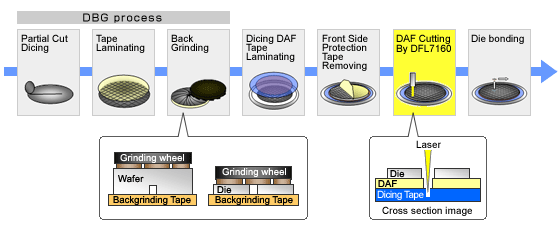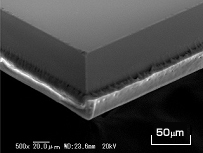DBG + DAF Laser Cut
Solutions
DBG (Dicing Before
Grinding)*1 process is capable of reducing backside chipping by separating the dies
during grinding, which also improves die strength. In addition, because the wafer is separated into dies
at the end of the grinding process, a reduction in the risk of wafer breakage can be expected during thin
grinding.
By applying DAF (Die Attach Film)*2 to the DBG process, it is possible to develop a DBG process
for the manufacturing of packages with stacked thin dies, such as SiP (System in Package).
When applying DAF to the DBG process, it is necessary to attach the DAF on the backside of the die
separated wafer and then cut just the DAF. DISCO engineers have developed an application to laser cut the
DAF at this juncture.
*1 DBG (Dicing Before Grinding) : The DBG process reverses the usual process of backside grinding and then
full cut wafer dicing. The DBG process first half-cuts the wafer and then separates the dies during the
backside grinding process.
*2 DAF (Die Attach Film) : DAF is bonding material attached to a film and is used for thin die stacking.
Application
Cutting DAF with blade dicing after the DBG process, currently has the following issues.
Blade DAF cutting issues after the DBG process
- Die Alignment
Die shift (kerf shift) may occur when attaching dicing tape and peeling the backside protection tape. If the die shift amount is large, it may not be possible to secure sufficient street width for the blade to pass. - Blade Width
Since a blade that is thinner than the street width (distance between dies) is necessary, precision processing is required. - Processing Speed
To maintain sufficient quality of the DAF after cutting, it may be difficult to process at high speed.
On the contrary, by using a laser to cut the DAF after the DBG process, it is possible to process the wafer corresponding to the die shift and improve the processing speed.
DBG + DAF Laser Cut Process
After the DBG process, the mounter transfers the wafer onto a frame. After the mounter peels the backside protection tape from the wafer, the laser dicer performs a laser full cut on the DAF from the backside of the wafer. Since the wafer is already separated into dies, the laser passes between the dies and cuts only the DAF.

Merits of DAF Laser Cut
Improves the DAF edge quality
By employing a laser dicer, it is possible to suppress the burring that occurs during blade DAF cutting.

Improves productivity by increasing the cutting speed
Compared to blade dicing, it is possible to increase the processing speed when performing DAF full cut
with a laser.
Process example: One pass DAF cutting at a processing feed speed of 100 mm/sec - 300 mm/sec.(Depending on
the DAF type, DAF thickness, wafer thickness and kerf width, processing conditions are different)
Responds to die shift with special alignmentv
If die shift occurs in the wafer after the DBG process, it is possible to follow the die shift by using special alignment. The special alignment remembers the position of the kerf center for every alignment point of each line, and then cuts through this center with the laser.

Process handling equipment
Contact
Please feel free to contact us with any questions or inquiries.
-

Applications Support
A free-of-charge test cut is performed at an application lab to confirm whether achieving the customer's needs is possible.
Details -

Dicing and Grinding Service
It is effective in sample and prototype manufacturing during development or low-volume production. Designated engineers will provide support based on the desired leadtime and at reasonable cost.
Details

